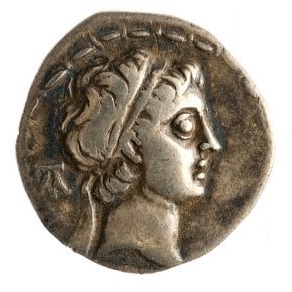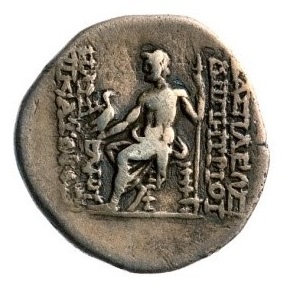Title: Drachma of Demetrios II - 1985.07
Acquisition number: 1985.07
Author or editor: Douglas Kelly
Culture or period: Hellenistic.
Date: 145 - 140 BC.
Material: Metal - Silver
Object type: Coins - Greek
Dimensions: 18mm (w)
Origin region or location: Iraq
Origin city: Seleukeia.
Display case or on loan: 5
Keywords: Coin, Greek, Hellenistic, drachma, Seleukeia, Syria, Demetrios II, Zeus, Seleukid, Babylonia
O. Hoover, Handbook of Greek Coinage 13 vols (Classical Numismatic Group, Lancaster, PA, 2009-2013), 9, 984.
A. Houghton, C. Lorber and O. Hoover, Seleucid Coins: A Comprehensive Catalogue, 2 vols (New York, Lancaster and London, American Numismatic Society and Classical Numismatic Group, 2002 and 2008), 1986.
1985.07
Drachma of Demetrios II
Silver 3.68 g. 18 mm. 145-140 BC (first reign).
Obv.: Head of Demetrios II, r.
Rev.: Seated Zeus l., holding eagle on right hand and sceptre in left. ΒΑΣΙΛΕΩΣ ΔΗΜΗΤΡΙΟΥ (‘of King Demetrios’) to right; and (unclear) ΘΕΟΥ ΝΙΚΑΤΟΡΟΣ (‘the divine conqueror’) to left.
Minted at Seleukeia on the Tigris.
After the death of Antiochos IV in 164 BC, the Seleukid empire went into decline, with intermittent and short-lived reversals, as encroachment by non-Greek powers was exacerbated by internecine civil war, in which the beginning and the end of a reign was usually marked by the killing of royal kin.
Demetrios II was the elder son of Demetrios I and overthrew Alexandros Balas with the assistance of Ptolemy of Egypt in 145 BC. His precarious rule was mostly confined to the cities of the Phoenician coast. In 139 BC he marched against the Parthians but was captured and remained in honourable captivity at the Arsakid court for the following decade.
When a successor Antiochos VII Sidetes invaded Parthia in 129 BC, Demetrios was released by his captors and managed to seize the kingdom. His second reign lasted till 125 BC.
While many issues of Demetrios II coins carry a date (see 2009.04), this issue does not. The attribution to the important Seleukid mint at Seleukeia on the Tigris (below Baghdad) firmly dates this coin, however, to the first reign, after which this region was lost to Parthia.
The ‘seated Zeus’ type occurs occasionally on the coinage of earlier Seleukid kings. In general, as the Seleukid empire contracted, the variety of obverse types, as well as denominations and weight-standards, became much greater. However, the royal portrait-heads are from finely engraved dies; each king stands out as an individual.
O. Hoover, Handbook of Greek Coinage 13 vols (Classical Numismatic Group, Lancaster, PA, 2009-2013), 9, 984.
A. Houghton, C. Lorber and O. Hoover, Seleucid Coins: A Comprehensive Catalogue, 2 vols (New York, Lancaster and London, American Numismatic Society and Classical Numismatic Group, 2002 and 2008), 1986.

